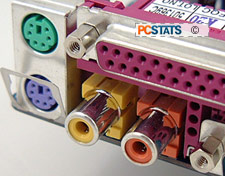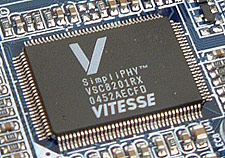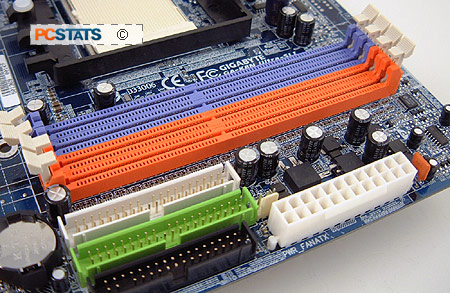Fully Featured Motherboard
|
Count on Dual BIOS'
BIOS stands for Basic Input/Output System and is programmed into
the computer's EEPROM memory. When you first boot up a system, the BIOS
loads and runs a POST test which detects and initializes the hardware within the
PC.
As components age, new BIOS' are released
which improve hardware compatibility, and/or increase performance. Flashing the BIOS with
a newer version can be tricky, especially with older hardware. A few
years ago, a "bad flash" could render a motherboard useless and require a
replacement board.
Dual BIOS'
eliminate the possibility of killing a motherboard with a bad
flash. If something were to go wrong during a flash, the motherboard would
automatically boot off the backup BIOS which then allows you to reflash
the main BIOS.
This removes the possibility of killing the motherboard while updating the
BIOS, which is a very real risk. We've done it at PCStats, and we've heard
many other horror stories from our readers! |
 The layout of the GA-K8N Ultra-SLI is excellent and users
will have an easy time installing this board into a case. All the ports and
headers are placed in the absolute best location. The layout of the GA-K8N Ultra-SLI is excellent and users
will have an easy time installing this board into a case. All the ports and
headers are placed in the absolute best location.
Absolutely everything you'll need to use the onboard peripherals is included. For
instance, eight Serial ATA cables are included as well as four
Molex Y Serial ATA power cable converters. That means users with many
HDDs or those who will be buying more do not have to shell out extra
money for the accessories too. We love to see motherboard manufacturers putting this kind of value
in their products.
We're
also pleased to see that Gigabyte is not simply including features to tick off a
check list. For instance, the GA-K8N Ultra-SLI comes with two Gigabit network
cards but neither run through the PCI bus. Instead the Marvell 8053 is PCI Express
based, and the Vitesse 8201 uses a special direct connection to the NF4-SLI chipset. That
means both these network cards will never bottleneck the PCI bus. Instead the Marvell 8053 is PCI Express
based, and the Vitesse 8201 uses a special direct connection to the NF4-SLI chipset. That
means both these network cards will never bottleneck the PCI bus.
It's nice to see that AMD has tackled heating and noise problems with its Cool
'n' Quiet feature. What C'n'Q does is automatically decrease the processor
clock/fan speeds when idle, thus saving electricity and producing less heat and
noise. When the motherboard detects more system activity, it will increase the
CPU speed to meet demand (up to 100% if needed) as well as increasing the fan speed once the
processor reaches a certain temperature.
There were
only a couple of minor issues we had with
this motherboard. First, the DIMM slots are too close together. We noticed that our Corsair
TwinX1024-3200XL Pro memory modules did not sit straight as the heatspreaders pushed
them apart. We didn't have this problem with other memory brands equipped
with heatspreaders though, it seems to affect Corsair's Pro and Xpert lines of
memory exclusively.

Also, the passive heatsink on the nForce4-SLI
chipset gets extremely hot
during operation. I couldn't even leave my finger on the heatsink for a few
seconds without the risk of burning myself, and that's too hot for comfort. You'd
better have good case cooling if you plan to use the GA-K8N
Ultra-SLI!
|
